TechRadar Verdict
The Whoop 4.0 fitness tracker looks much like its predecessor, with a simple screenless design, but there are some major changes under the hood including new SpO2 and temperature sensors, all packed into a smaller case. Data is synced with the Whoop smartphone app, where you'll find a wealth of health and fitness stats to help you optimize your training, sleep routine, and lifestyle to perform at your best. If you're not deeply invested in sport then it'll likely be overkill, but if you want to push yourself to the next level then it's an excellent tool.
Pros
- +
Lots of health data
- +
Big focus on recovery
- +
Very comfortable
- +
Useful ‘always-on’ charging
Cons
- -
No screen
- -
No smartwatch features
- -
Very basic design
- -
Only for those serious about fitness
Why you can trust TechRadar
Two-minute review
The Whoop 4.0 is the latest health and fitness tracker from tech company Whoop. It looks similar to the Whoop 3.0, which we reviewed in 2021. But there are some notable upgrades, including added sensors to collect more health data (like your blood oxygen level and skin temperature), a smaller design and a vibrating wake-up alarm.
Unlike the current crop of fitness trackers from brands like Fitbit or Garmin, the Whoop 4.0 has no screen or buttons. This design takes some getting used to. Anyone who wants smartwatch apps or workout stats on their wrist won’t like it. But for those interested in health and fitness tracking and nothing else, it might be a welcome break from 24/7 screens.
The Whoop 4.0 is a hardcore fitness device that doesn’t just track steps, gym sessions and calorie burn. Instead, it focuses on recovery. It aims to make sure you feel well-rested, so you’re working at an optimal performance level next time you exercise – that way, you’re more likely to avoid injury and over-exertion.

The Whoop 4.0 presents data about your sleep, recovery levels and how much strain your body is primed for each day. The Whoop algorithm that makes these calculations takes a range of factors into account, including where you’re at in your menstrual cycle, how well you slept last night, your heart-rate variability, your temperature and much more.
With its lack of screen, minimal design and app packed with data, the Whoop 4.0 isn’t for everyone. However, we enjoyed testing it and believe that if you’re keen to perform at your peak, sort out your sleep routine, prioritize rest, prevent injury or just love finding out more about your health and fitness; it’s one of the best wearables around.
Whoop 4.0 price and release date
The Whoop 4.0 launched in late 2021 and is available now. But you can only get one with a Whoop membership.
A membership costs £30 / $30 / $44AUD if you want to pay monthly without a big commitment – although this option comes with a six-month minimum term.
Sign up for breaking news, reviews, opinion, top tech deals, and more.
Signing up for annual membership works out at $24 / £24 / AU$32 per month. The catch is you need to pay it all in one go at $288 / £288 / AU$384. Alternatively, there’s an 18-month membership, which will cost you $18 / £18 / AU$24 per month. This is also charged all at once at $324 / £324 / AU$432, but it’s a significant saving on the original monthly price.
You pay for the membership with all of these options, and you get the Whoop device for free. This model makes it tricky to directly compare the Whoop 4.0 to other trackers in terms of value for money.
For people who can’t afford to spend more than $300 / £300 / AU$550 on a new device in one go, it’s more accessible. For those who can’t commit to regular payments or wouldn’t want to part with a big sum all at once, it could put them off.
In terms of price comparison, the Apple Watch Series 7 currently starts at £369 / $399 / AU$599, and the Fitbit Sense is $329 / £299 / AU$499.95. These are large, one-off payments, but you don’t need a membership to use them.
However, some services allow you to unlock more features with a premium subscription, like Fitbit Premium. This is $9.99 / £7.99 / AU$14.99 per month or $79.99 / £79.99 / AU$129.99 for a one-off year-long payment.
It’s tricky to put the Whoop 4.0 head-to-head with any of our best smartwatches because it’s a different proposition. It’s screenless, for starters, and it’s also heavily focused on performance, rest and recovery, collecting lots of data. In this way, it’s more comparable to the Oura (Gen 3) ring, with prices starting at $299 (about £230 / AU$420).
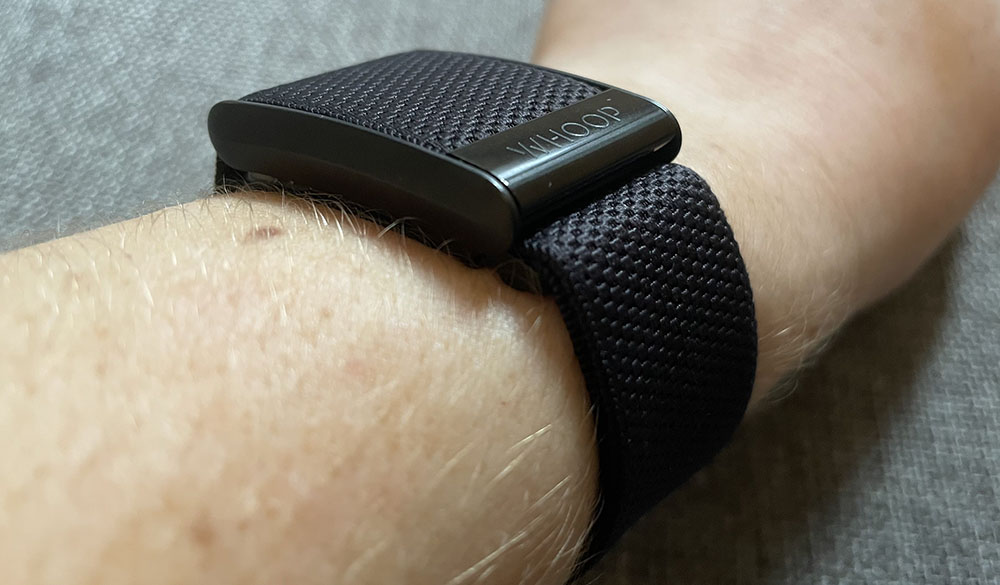
Whoop 4.0 design
The main body of the Whoop 4.0 is small and rectangular, with a plastic casing. This is where the battery is housed, and the sensors are on the underside.
This then clips onto an elasticated fabric strap. We found the overall look and feel of the Whoop 4.0 to be minimal and unobtrusive as it sits flush against your arm, and there’s no screen or buttons to get in the way.
It has a slightly improved design over the Whoop 3.0. Whoop says the 4.0 is now 33% smaller. It certainly felt easy to wear and never got in the way during showers, workouts and anything else – which is rare, even with the most streamlined of wearables.
The elasticated band feels a little like a seatbelt at first but, like the Whoop 3.0, we found this to be incredibly comfortable at all times because the fabric is sturdy yet soft, and you can adjust it to get the perfect fit.
This is hugely important with wearable devices that have sensors on the back. If they don’t fit snugly but comfortably, you’ll see the bright sensor lights flashing throughout the night – that’s not ideal if you’re wearing one to help you get a better night’s sleep.
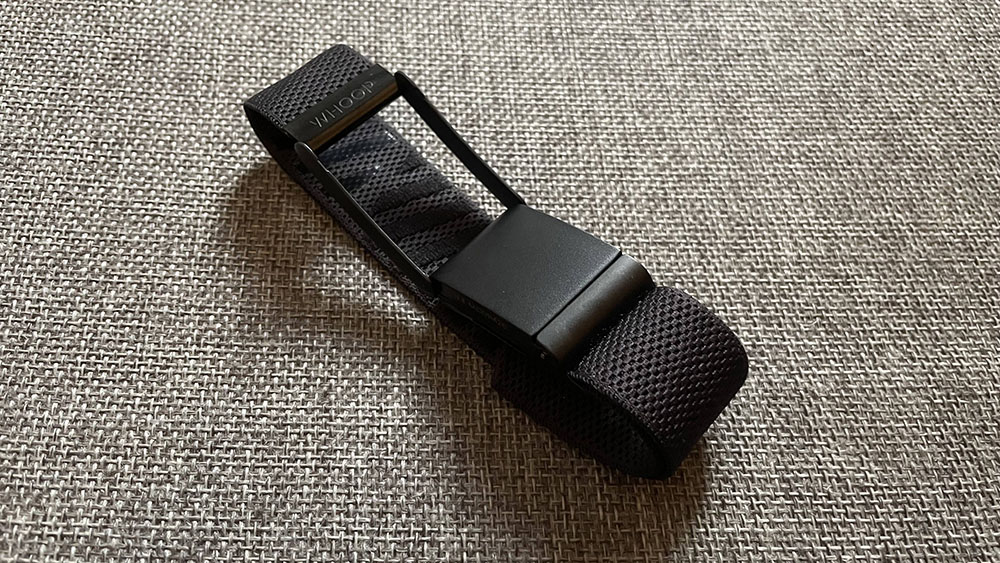
The Whoop 4.0 has an IP68 rating, which means it’s dustproof and water-resistant. It’ll handle depths of up to 10 metres for 2 hours. You can keep it on when you’re showering, swimming and sweating. Although we found that if we wore it in the shower, it needed to be taken off to dry, otherwise it felt really soggy. What’s good about the latest version of the Whoop is that the charger has this same rating, too – the previous version’s charger wasn’t water-resistant at all.
The Whoop we’re testing here is the black version with a SuperKnit band – called Onyx – but there are different color options, including blue, white, silver, green, rose gold and more. You can also choose from a wide range of colored bands to create unique looks. Changing straps is easier with the Whoop 4.0. You just need to unhook the main body of the Whoop from one end and unthread it from the other.
Interestingly, you don’t even have to wear the Whoop 4.0 on your wrist. Whoop has recently brought out a new ‘body’ collection of clothing with its latest wearable, which includes boxers, bralettes, leggings and other kinds of sports gear fitted with special ‘pods’ that you can slide the main body of the Whoop into. We haven’t tried these out for ourselves yet, but we’re interested in the flexibility of getting the same stats by wearing the Whoop 4.0 in different ways.

Whoop 4.0 health and fitness tracking
The Whoop 4.0 tracks a lot of data, focusing on three key areas of your health and fitness: recovery, sleep and strain. It then offers feedback about how much you should be pushing yourself each day through the Whoop app.
Your level of recovery and exertion (called strain) scores are worked out based on several factors, including your workouts, how well you rested last night, where you’re at in your menstrual cycle, your heart rate variability (HRV), and much more.
Some of these metrics are new to the Whoop 4.0 thanks to improved sensors on the underside of the device, which can now measure your blood oxygen levels (SpO2) and skin temperature. Many of these readings are taken at night while you sleep to ensure you get the most reliable data.
This health data enables Whoop’s algorithm to give you an even more accurate reading of your sleep, overall health, exertion and recovery, helping you identify when you’ve deviated from your baseline and assisting the whoop in making more accurate recommendations about how much you should push yourself each day.

You begin each day with a level of recovery. Your goal is to match your strain level to your recovery level to perform at your best or aim lower for a rest day.
We found this focus extremely useful, as no two days are ever the same, and Whoop takes some of the guesswork out of how hard you should push yourself when you wake up each morning. For example, it can be hard to determine if you’re just feeling lazy and need to find the motivation to move or whether you’re genuinely not up for training today and pushing yourself might leave you exhausted or even cause injury.
As well as getting a strain score for the day, you also get one when you begin an activity. You can track a vast range of activities, including weightlifting, walking, running, barre, climbing, cycling and much more. We found the measurements while you're working out, including duration, calorie burn and time in different heart rate zones, to be accurate and highly responsive, too.
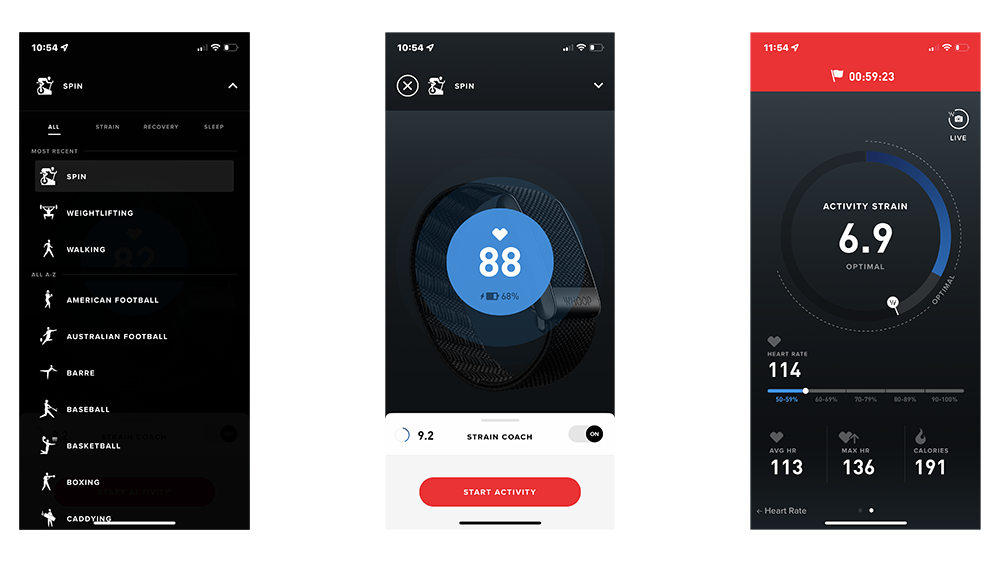
Whoop 4.0 companion app
When we reviewed the Whoop 3.0, our biggest complaint was connectivity issues. But these were all ironed out during our testing of the Whoop 4.0. Setting up the device was simple and took only a few minutes. Data syncing then remained consistent and reliable over the course of three weeks.
The Whoop app presents you with lots of data about you and your body to comb through. We found this dizzying at first as there are a few different menus, and you can tap into graphs to find out even more. But Whoop makes it reasonably straightforward to navigate through all of these stats with color-coded insights, clear presentation and a significant amount of extra info and coaching to make all of the numbers meaningful.
The main dashboard is packed full of information, but easy-to-understand with a circle at the top of each day that presents two rings: one with your recovery for the day, the other with the strain you’ve exerted – the goal being to match them up if you want to perform at your peak. Although it's worth noting that you don't have to hit that goal each day.
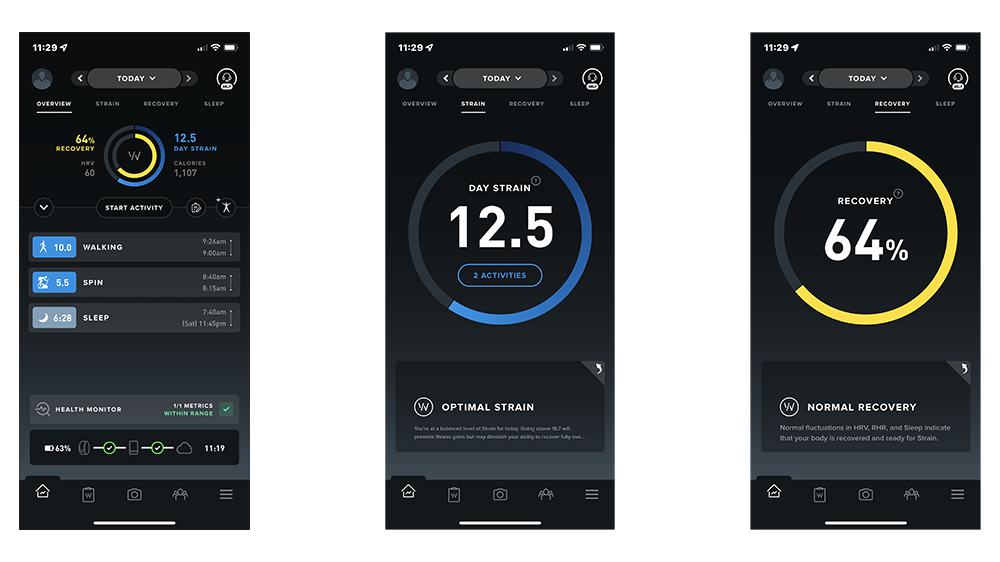
The Whoop 4.0 app has several coaching features. For example, each time you start a new activity, a ring appears. This ring fills up the more you workout, based on data like your workout session length and heart rate.
A feature called strain coach adds points around the ring that suggest the level to aim for if you want to push yourself or if you want to have a calmer, less strenuous workout instead. We like this feature as it gave us something to aim for each workout session rather than waiting to see if we hit our goals for the day after it was over – although that does mean you need to keep your phone close to you.

There’s also a sleep coaching section. This is where the Whoop app tells you how long you need to sleep to achieve optimum recovery levels the next day and when you’ll need to go to bed.
You can tweak these settings depending on how you want to feel tomorrow. For example, I just told the app I want to feel at my ‘peak’ tomorrow, and it suggested I aim for eight hours of sleep. If I were to change that to just ‘perform’, I’d need seven hours 37 minutes, and to ‘get by’, I’d need six hours 16 minutes. These numbers change as the Whoop learns more about you and the sleep you need each night to get a full recovery.
A feature new to the Whoop 4.0 is that once you’ve set your sleep coach goal, you can turn on a vibrating alarm that will wake you when you've reached that goal. You can also set the alarm to wake you up at the latest time possible, just in case you don’t hit your goal all night. We found it extremely useful to base our wake up time on when we were most rested, not when we must get up. It lead to better sleep, and much more energized mornings.
Sleep tracking is highly accurate and there’s a lot of information about how well you sleep each night to comb through, including how long you slept, the time you spent in different sleep stages, the number of times you woke up, your respiratory rate and more. This is presented in a series of really fascinating graphs, including one that visualizes all the fluctuations of your heart rate throughout the night with your sleep stages overlaid onto it.
Although the Whoop 4.0’s sleep coach is great for helping you get the right amount of sleep, it’s these graphs that can be extremely useful if you’re trying to get a better idea of how you sleep and what might be affecting your sleep. They’re also handy if you’re concerned about your sleep as they’ll give your doctor a lot of information.

Whoop has recently introduced Menstrual Cycle Coaching. If you’re someone who menstruates, you input data each day about your cycle and then you’re given insights about how each phase might affect your sleep and your strain. This is reflected in your recovery level and strain goal each day, too.
This is a welcome feature as it acknowledges just how much energy levels and training can be affected by different phases in your menstrual cycle. We found this information to be beneficial throughout the month, not only informing us when we should take it a bit easier but helping us become more aware of these natural fluctuations and working with them, not against them.
Whoop 4.0 battery
To charge up the Whoop 4.0, you need to slide a small charging device onto it. This means you technically never have to take it off and can even wear it in the shower thanks to the most recent upgrade, as the charger is now IP68 dustproof and water-resistant.
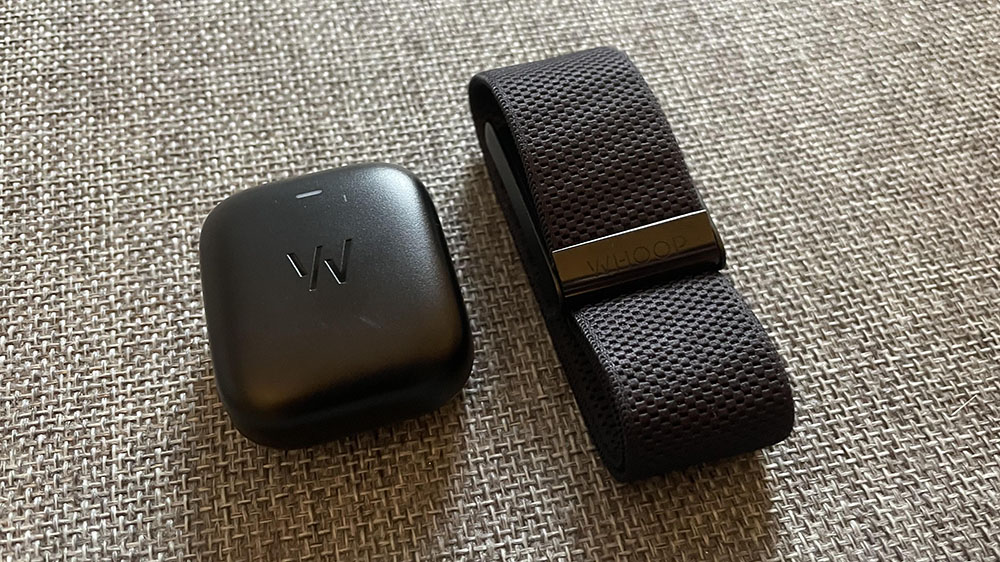
Wearing the Whoop and the charger on top does make it bulkier. So even though it’s designed to be charged up whenever you need to, it does make tucking it under tight sleeves difficult and can get in the way during certain workouts.
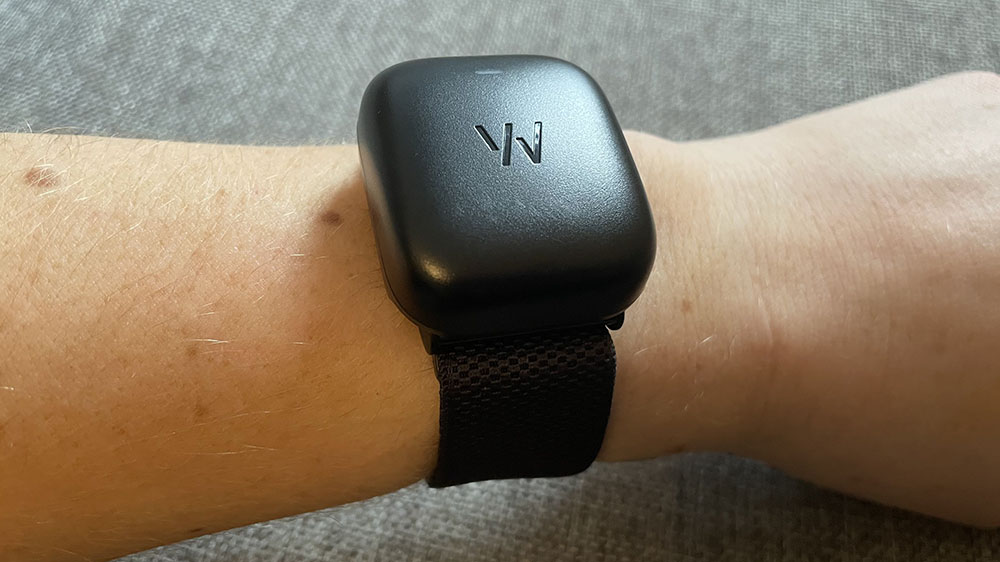
We found this charging method took a few weeks to get used to because you have to make sure the charger is juiced-up via USB first before you can use it to charge the Whoop 4.0. But once it becomes second nature, you won’t want to go back to taking off a fitness tracker to charge it up – like you do with other wearables.
Once you have the charger on the device, it takes around 2 hours to go from 1% up to 100%. Whoop promises this will then last you up to 5 days before you need to charge again. We found this to be fairly accurate and needed to charge it up after 4.5 days and that was when we were logging at least one workout session per day.

Buy it if
You want to improve your sleep
The Whoop 4.0 is focused on recovery and sleep. With data collected throughout the night, including HRV, SpO2 and your respiratory rate, info about time spent in sleep zones, a coaching feature to wake you up and much more. This is ideal if you’re keen to improve your sleep, interested in what might impact your sleep quality or want to collect data throughout the night about your health.
You want to improve your training
The Whoop shines if you’re interested in digging into data about sleep, recovery, menstrual tracking, and anything else that might impact your ability to perform at your best. So if you’re interested in training, performing well and avoiding overexertion or injury, it’s a great way to not only track your workouts but ensure key health metrics are where they need to be.
You want a simple design
We found the design of the Whoop 4.0 to be comfy and discreet. There are ways to customise your Whoop, but this is (for the most part) a minimal and straightforward tracker. If you like the sound of that, it’s a much better option than something bulky and flashy.
Don't buy it if
You’ll miss a screen
If you want to use a wearable device to tell the time, add smartwatch features, set timers, get apps, see data live on your wrist as you workout, or anything else involving a screen, this isn’t for you. As great as the Whoop app is, there’s no getting around the fact this device doesn’t have a screen. This is freeing and appealing to some, a massive deal-breaker for others.
You don’t need loads of data
The Whoop 4.0 is all about data. Data about your blood oxygen levels, workouts, running routes, sleep, recovery, energy and everything else. This is exciting and extremely useful if you’re interested in your health and fitness. If you find the idea of endless pie charts and graphs overwhelming, look elsewhere.
Fitness isn’t a priority for you
You don’t need to be a pro athlete to get a lot from the Whoop. You don’t even need to do intense workouts – there are options to track walking and light activities and there’s a lot of interesting and helpful health data here that could be beneficial for various reasons. However, it is mostly aimed at those who want to train a lot and need to know when they should take it easy. For everyone else, it might get a little too serious and data-heavy quickly.
- We've tested the best running watches and best swimming watches

Becca is a contributor to TechRadar, a freelance journalist and author. She’s been writing about consumer tech and popular science for more than ten years, covering all kinds of topics, including why robots have eyes and whether we’ll experience the overview effect one day. She’s particularly interested in VR/AR, wearables, digital health, space tech and chatting to experts and academics about the future. She’s contributed to TechRadar, T3, Wired, New Scientist, The Guardian, Inverse and many more. Her first book, Screen Time, came out in January 2021 with Bonnier Books. She loves science-fiction, brutalist architecture, and spending too much time floating through space in virtual reality.
